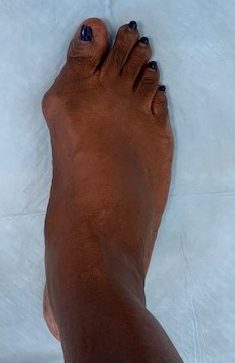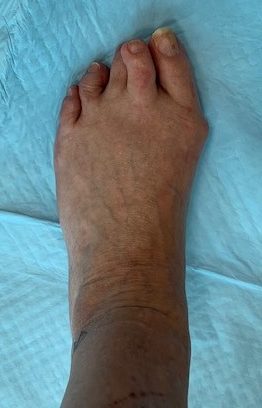What are bunions?
There is a good chance you have heard of the term “bunion” or know someone who has it or have it yourself. Bunions otherwise known as hallux abductovalgus is a common deformity of the foot where there is a bump on the inside of the big toe. It is more complex than just a bump, it is a change in framework of how your foot functions and this bump may be the cause of symptoms in other parts of your foot. Some bunions are symptomatic, and others are just a cosmetic inconvenience. Bunions may be progressive where the bump becomes larger, the big toe moves closer to the second toe and at times overlaps or underlaps the second toe.

What causes bunions?
Bunions causes are multifactorial from family inheritance, ligament instability, joint adaptation or simply idiopathic (bad luck).
Common causes:
- Family history
- Ligament laxity in the foot
- Poor biomechanics
- Ill-fitting shoe gear
- Injury
- Atavistic deformity
- Many more
What are the symptoms of bunions?
Typically, if the bunions are symptomatic the common symptom is pain on the bump caused by irritation of the shoe gear. This causes changes to the skin texture, swelling, pain and redness. Women who wear closed toe shoes, tight fitting shoes and high heels may experience more symptoms compared to men who wear wider toe box tennis shoes. Some of the other symptoms experienced by patients are big toe pain, second toe pain, pain under the ball of the second toe, hammer toe deformity, callus, big toe overlapping or under lapping the second toe and more.
Common Symptoms:
- Pain
- Burning sensation
- Swelling
- Callus
- Crossing toes

How are bunions diagnosed?
Bunions may be diagnosed clinically by examination of your foot. Radiographs (X-rays) are usually acquired to determine the degree of deformity, the apex of deformity, anatomic assessment, and surgical planning.
Non-operative treatment
In most cases of symptomatic bunions some sort of treatment is required. The goal of non-operative treatments is to accommodate the deformity to reduce symptoms during function. These treatment options do not reduce or correct the deformity.
- Shoe gear modifications
- Wider toe box in shoes to accommodate the deformity
- Padding
- Padding over the bump can help minimize size irritation and pressure
- Anti-inflammatory Medications
- Oral anti-inflammatory medications if recommended by your doctor to reduce the swelling and pain
- Injection
- Local steroid injection can help reduce swelling and pain
- Orthotics
- In some cases, orthotics may be indicated
Operative treatment
The goal for operative treatment is to correct the deformity, reduce the pain and increase function. Not all bunions are alike, not all patients have the same goals and not all treatment options are the same. Surgical treatment options are tailored to patients’ goals and deformity.
- Minimally invasive surgical options
- Pros: cosmetically appealing scar, less swelling, less pain, faster recovery, and less down time, good option for mild to moderate deformities.
- Cons: may not be a good option for severe deformities, higher incidence of recurrence with instability of the foot.
- Fusion of tarsometatarsal joint (Lapidus)
- Pros: good option for moderate to severe deformities, provides stability to the joint which may be unstable causing the deformity, less chance of recurrence.
- Cons: bigger incision, post-operative stiffness, more downtime, more swelling
- Fusion of the first metatarsalphanageal joint (big toe)
- Pros: good option for mild, moderate, and severe deformity, address arthritic joint pain, less down time.
- Cons: bigger incision, swelling, stiffness
- Other options
- Open distal metatarsal bunion procedures, open metatarsal shaft procedures, and proximal shaft procedures
Post operative protocol
In general, patients with minimally invasive surgical treatment can be weightbearing as tolerated immediately post operatively in a surgical shoe for 4-6 weeks and then transition to supportive shoes. With the Lapidus procedure, patients are non-weightbearing for 2-4 weeks to allow bone to heal and minimize swelling. Thereafter, patients can be weightbearing as tolerated in surgical boot and then supportive regular shoes.
Here is an animated video of a minimally invasive bunion surgery technique example.
Until next time…
Dr. P
Book An Appointment Today!
Call (281) 501-0018
Visit Our Website: www.epicfootandankle.com
The information is provided for your assistance only; this information does not provide medical advice. You should never diagnose or treat yourself for a medical condition based on the information provided herein, and the information is not provided for that purpose. Likewise, you should never determine that treatment is unnecessary based on this information. The information contained herein is not a substitute for medical care provided by a licensed medical professional. The information provided herein is not medical or professional advice. This information does not create a doctor-patient relationship.
This information contained herein, is provided to you as a service for use at your sole risk.
If you are feeling ill, please seek medical attention in person right away. In the case of an emergency, please go to the nearest hospital.
